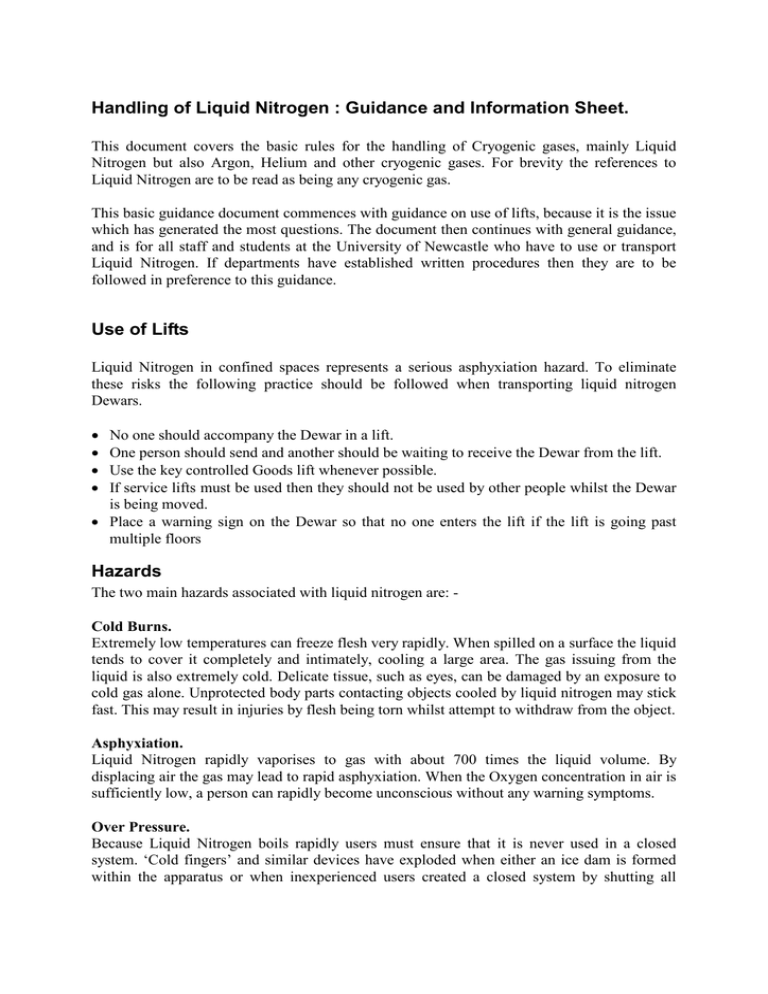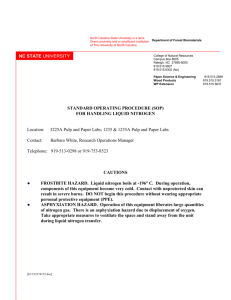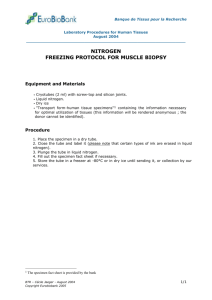Handling of Liquid Nitrogen : Guidance and
advertisement

Handling of Liquid Nitrogen : Guidance and Information Sheet. This document covers the basic rules for the handling of Cryogenic gases, mainly Liquid Nitrogen but also Argon, Helium and other cryogenic gases. For brevity the references to Liquid Nitrogen are to be read as being any cryogenic gas. This basic guidance document commences with guidance on use of lifts, because it is the issue which has generated the most questions. The document then continues with general guidance, and is for all staff and students at the University of Newcastle who have to use or transport Liquid Nitrogen. If departments have established written procedures then they are to be followed in preference to this guidance. Use of Lifts Liquid Nitrogen in confined spaces represents a serious asphyxiation hazard. To eliminate these risks the following practice should be followed when transporting liquid nitrogen Dewars. • • • • No one should accompany the Dewar in a lift. One person should send and another should be waiting to receive the Dewar from the lift. Use the key controlled Goods lift whenever possible. If service lifts must be used then they should not be used by other people whilst the Dewar is being moved. • Place a warning sign on the Dewar so that no one enters the lift if the lift is going past multiple floors Hazards The two main hazards associated with liquid nitrogen are: Cold Burns. Extremely low temperatures can freeze flesh very rapidly. When spilled on a surface the liquid tends to cover it completely and intimately, cooling a large area. The gas issuing from the liquid is also extremely cold. Delicate tissue, such as eyes, can be damaged by an exposure to cold gas alone. Unprotected body parts contacting objects cooled by liquid nitrogen may stick fast. This may result in injuries by flesh being torn whilst attempt to withdraw from the object. Asphyxiation. Liquid Nitrogen rapidly vaporises to gas with about 700 times the liquid volume. By displacing air the gas may lead to rapid asphyxiation. When the Oxygen concentration in air is sufficiently low, a person can rapidly become unconscious without any warning symptoms. Over Pressure. Because Liquid Nitrogen boils rapidly users must ensure that it is never used in a closed system. ‘Cold fingers’ and similar devices have exploded when either an ice dam is formed within the apparatus or when inexperienced users created a closed system by shutting all valves. Tape exposed glass parts to minimise the hazard of flying glass shards. Cryotube Explosions. Cryotubes used to contain samples stored under liquid nitrogen may explode without warning. Tube explosions are thought to be caused by liquid nitrogen entering the tube through minute cracks or incorrectly sealed tubes and then expanding rapidly as the tube thaws. The image below shows cryovials that are commonly available, the safety office recommends laboratories use the cryovials seen on the left as these have male connectors and a rubber seal which prevents liquid nitrogen entering the vial. Under no circumstances should an Eppedorf tube with snap lid be used as seen below. These tubes are not fully sealed and allow liquid nitrogen to enter the tube, greatly increasing the risk of explosion. If you retrieve a long term sample from liquid nitrogen in an Eppendorf tube then extreme care should be applied and the tube should be discarded unless absolutely necessarily required. In these cases please consult your school safety officer. When thawing Cryotubes take the following precautions: • • • • Wear a face shield Wear heavy gloves. Wear a buttoned lab coat and trousers or long skirt. Place the Cryotube in a heavy-walled container (e.g., a desiccator) or behind a safety shield while it is thawing. Embrittlement. Many ordinary materials cannot withstand cryogenic temperatures. Laboratory plumbing is one example, therefore never dispose of cryogenic liquids down the drain. Materials exposed to cryogenic temperatures for long periods or which have undergone periodic warming and freezing should be examined for cracks. Precautions. Local rules for Liquid Nitrogen safety. Local rules exist for handling Liquid Nitrogen in association with specialist equipment. All such local rules must be adhered to. Storage of Dewars on rooms. Storing single Dewars of up to 25L in rooms is considered acceptable. However the storage of large numbers of small Dewars or Dewars over 25L capacity may require additional precautions to be taken. In these circumstances consideration should be given to the size of the room; the storage conditions; ventilation levels; and, the possible use of low Oxygen level alarms. Further advice on a case by case basis is available from the Safety Office. Dewars must not be stored in sealed rooms (e.g. walk in refrigerated rooms) because the reduced ventilation may be inadequate to mitigate against spillage and general evaporation. Containers. Use only containers designed for low-temperature liquids. Cryogenic containers (e.g. Dewar flasks) are specifically designed and made of materials that can withstand the rapid changes and extreme temperature differences encountered in working with Liquid Nitrogen. Even so, these special containers should be filled SLOWLY to minimise the internal stresses that occur when any material is cooled. Excessive internal stresses can damage the container. • Do not cover or plug the entrance opening of any Liquid Nitrogen refrigerator or Dewar. • Do not use any stopper or other device that would interfere with venting of gas. Cryogenic liquid containers are generally designed to operate with little or no internal pressure. Inadequate venting can result in excessive gas pressure which could damage or burst the container. Check the unit periodically to be sure that venting is not restricted by accumulated ice or frost. Protective Clothing. When using or decanting Liquid Nitrogen a face shield must be used. Always wear appropriate cryosafety gloves when handling anything that is, or may have been, in immediate contact with Liquid Nitrogen. Use tongs to withdraw objects immersed in the liquid, and handle the object carefully. Do not put hands (even in the best gloves) into Liquid Nitrogen. Appropriate gloves are thermal protective gloves which are specifically designed for cryogenic use preferably with close fitting ribbed cuffs to prevent liquid Nitrogen from spilling inside the glove. Alternatively use cryogenic long half arm gloves that fit loosely, so that they can be removed quickly in the event of an incident. The surface of the glove should be textured to provide a sure grip on cold slippery surfaces thus helping to prevent other associated accidents. Inadequate protective clothing can absorb the Liquid Nitrogen and result in even more severe burns than would otherwise have resulted. Additionally, when handling liquid in open containers, it is advisable to wear high-top shoes. Trousers (which should be cuff-less if possible) should be worn outside the shoes. Training. Full training should be given prior to handling liquid nitrogen, all staff and students should consult with the school safety officer prior to this kind of work and a full risk assessment completed. Handling of Liquid Nitrogen. Decanting of Liquid Nitrogen. Never overfill Dewars. Spillage damages flooring and may cause injury. Insert pipes and funnels slowly to avoid splashing. Great care should be exercised to ensure that space is left to replace lids/tops on Dewars especially those that insert a considerable distance into the vessel. Spills and splashes can set off oxygen monitors. Maintenance of Dewars. All large Dewars (25 litres or larger) should be subject to annual maintenance checks. Smaller Dewars should be visually inspected each time they are refilled and any defects must be reported to the appropriate Departmental Superintendent. Condensed moisture or frost on the outer shell of a refrigerator or Dewar and abnormally rapid evaporation of the liquid nitrogen are indications of vacuum loss. If vacuum loss is evident or suspected, transfer the materials stored in the unit to another refrigerator as soon as possible and remove the unit from service. Use correct equipment. Use a phase separator or special filling funnel to prevent splashing and spilling when transferring Liquid Nitrogen into or from a Dewar or refrigerator. The top of the funnel should be partly covered to reduce splashing. Use only small, easily handled Dewars for pouring liquid. When liquid cylinders or other large storage containers are used for filling, follow the instructions supplied with those units and their accessories. Never use hollow rods or tubes as dipsticks. When a warm tube is inserted into liquid nitrogen, liquid will spout from the bottom of the tube due to vaporisation and rapid expansion of liquid inside the tube. Wooden or solid metal dipsticks are recommended if absolutely necessary. Transport. Only use closed "onion" (25 litre) Dewars and "transport" Dewars when moving Liquid Nitrogen. Always work in pairs when moving a Dewar. Keep unit upright at all times. Tipping the container or laying it on its side can cause spillage of liquid nitrogen. It may also damage the container and any materials stored in it. Dropping the container, allowing it to fall over on its side, or subjecting it to sharp impact or severe vibration can result in partial or complete loss of vacuum. To protect the vacuum insulation system, handle containers carefully. Do not "walk", roll or drag Dewars across a floor. Large units are heavy enough to cause personal injury or damage to equipment if proper lifting and handling techniques are not used. Do not place Liquid Nitrogen containers in closed vehicles where the nitrogen gas that is continuously vented can accumulate. Disposal. Never dispose of cryogenic liquids down the drain. Ordinary materials may not be able to withstand cryogenic temperatures without failure. Laboratory plumbing is a common example. Allow waste Liquid Nitrogen to evaporate naturally in a fume hood or, preferably, pour the liquid slowly on gravel or bare earth, from which other people are excluded, where it can evaporate without causing damage. Do not pour the liquid on the pavement. First Aid. Skin/Eye Contact. • Immediately flush thoroughly with copious quantities of tepid water (the water must not be hotter than 44oC). In case of frostbite spray with water. • DO NOT apply any form of direct heat. • DO NOT rub affected parts either before or after warming. • Move the patient to a warm place (22 C). • Arrange for the casualty to be transported to hospital without delay. While waiting for transport : • Remove or loosen restrictive clothing. • Continue to flush the affected area with copious quantities of tepid water. • Protect any frozen parts with bulky, dry, sterile dressings. Do not apply to tightly. • • • Keep patient warm and at rest. Ensure ambulance crew/hospital is advised of details of accident and first aid treatment already administered. The patient should neither smoke, nor drink alcohol. Anoxia. Attempts to rescue affected persons from confined spaces or where oxygen deficient atmospheres may be present should only be made by those trained in the use of breathing apparatus and confined space entry procedures. The Fire Brigade should be called in all instances where a trapped person requires rescue. If a person seems to become dizzy or loses consciousness while working with liquid nitrogen, move to a well-ventilated area immediately. If breathing has stopped, apply artificial respiration. Keep warm and at rest. The patient should neither smoke, nor drink alcohol.



